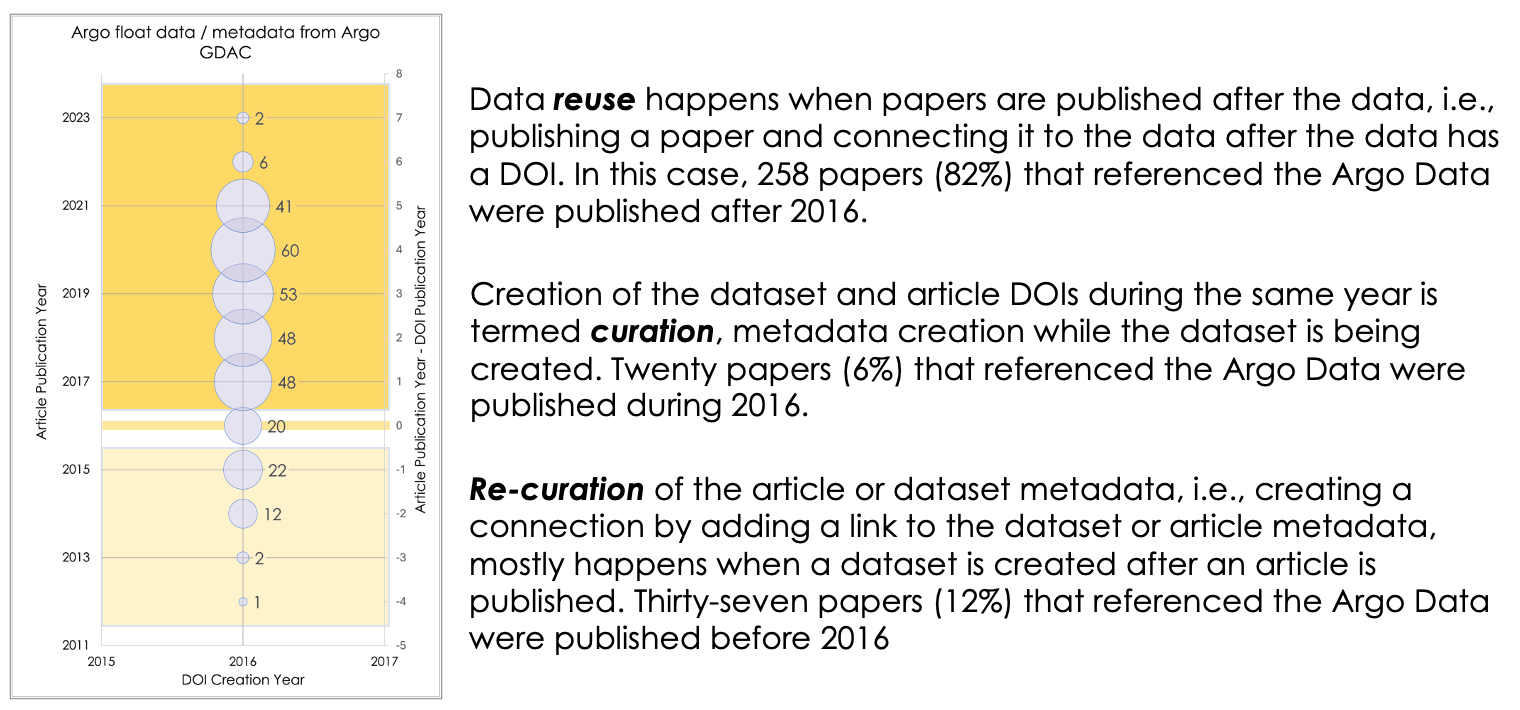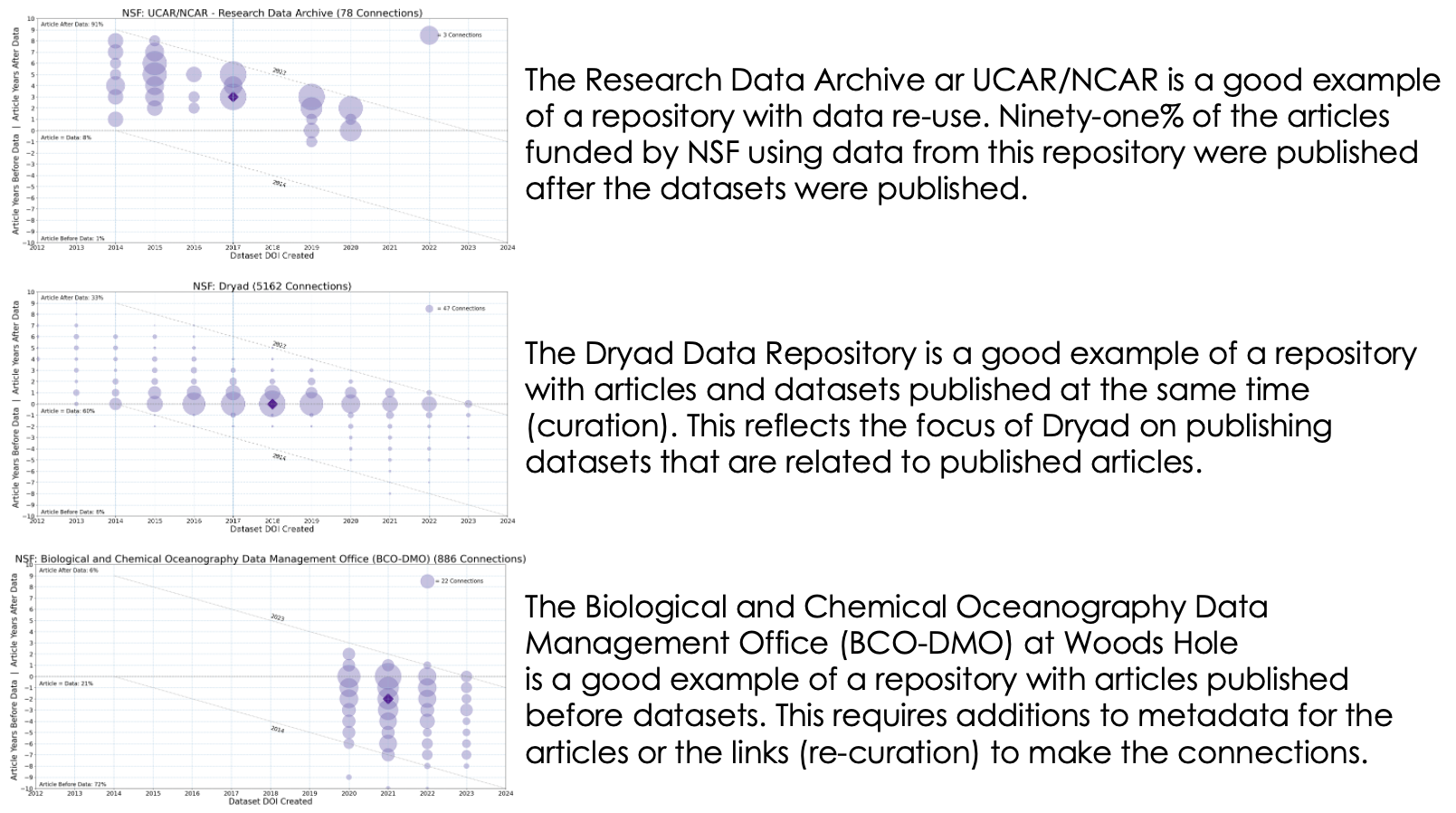In a recent Upstream blog post we explored where data connected to papers funded by several U.S. Federal Agencies are published. Different data sharing practices across these agencies led to very different distributions of datasets across various repositories. We used CHORUS reports that combine linked article and dataset metadata as input for that work.
The links provided by CHORUS also facilitate comparisons of publication dates for articles and datasets. The Argo Float dataset (10.17882/42182) was cited by over 300 articles funded by NSF between 2012 and 2023. This is a small subset of all articles that use this dataset (Argo Publications), but it provides an example of how comparing publication dates can shed light on temporal relationships of articles and datasets.
Figure 1 compares publication dates for the articles and the creation of the Argo Float dataset DOI. The x-axis shows the creation year of the data DOI (2016). The y-axis show the publication year of the articles (2011 to 2023) on the left and the relative timing of the publications on the right. The number of articles / year is shown as bubble size and as text beside the bubbles.

Figure 1 suggests a nomenclature of three terms that may be helpful for describing these temporal relationships and related repository behaviors. First, many repositories are focusing significant efforts on facilitating reuse of data they steward. Reuse success appears as bubbles above the centerline in Figure 1, i.e. articles published after datasets. Second, many scientific journals and funders are requiring submission of datasets to repositories as papers are published and structured references to those datasets (Stall et al., 2023). This practice, termed curation, appears as bubbles on the centerline of Figure 1, i.e. article publication date = dataset publication date. Finally, many domain repositories are extracting data from past articles and publishing it with identifiers. Connecting these past articles to the newly published data requires adding a connection into the metadata for the paper or into a link repository like ScholeXplorer. This metadata augmentation is a re-curation process.
This same visualization can be created for multiple datasets in a repository. Examples of these visualizations, termed Connection Timelines, for repositories that focus on re-use, curation, and re-curation are shown in Figure 2.

Making these connections with links from publicly available CHORUS reports currently limits the data to articles funded by specific funders, NSF in this case, so the timelines are only for subsets of datasets in these repositories. In many cases, these subsets include hundreds or even thousands of connections, so they may still reflect general repository behaviors.
Connection timelines for many more repositories, described on this poster and available here, include many examples of these behaviors and many repositories with mixed behaviors. Future work will explore other approaches to finding connections to broaden the examples and improve understanding of data reuse, curation, and re-curation as well as repository behaviors.
Acknowledgments
This work is part of the INFORMATE Project, a partnership between Metadata Game Changers and CHORUS. This work was funded by the U.S. National Science Foundation, award 2134956.
References
Argo. (2024). Argo float data and metadata from Global Data Assembly Centre (Argo GDAC) [dataset]. SEANOE. https://doi.org/10.17882/42182
Argo Publications (2023). https://argo.ucsd.edu/outrech/publications/.
Habermann, T., & Robinson, E. (2024). What Came First: The Paper Or the Data (p. 6245187 Bytes). ESIP. https://doi.org/10.6084/M9.FIGSHARE.25139354.V1
Habermann, T., Jones, J., Ratner, H., & Packer, T. (2023). INFORMATE: Where Are the Data? https://doi.org/10.54900/vnevh-vaw22
Stall, S., Bilder, G., Cannon, M., Chue Hong, N., Edmunds, S., Erdmann, C. C., Evans, M., Farmer, R., Feeney, P., Friedman, M., Giampoala, M., Hanson, R. B., Harrison, M., Karaiskos, D., Katz, D. S., Letizia, V., Lizzi, V., MacCallum, C., Muench, A., … Clark, T. (2023). Journal Production Guidance for Software and Data Citations. Scientific Data, 10(1), 656. https://doi.org/10.1038/s41597-023-02491-7
Copyright © 2024 Ted Habermann, Jamaica Jones, Howard Ratner, Tara Packer. Distributed under the terms of the Creative Commons Attribution 4.0 License.







